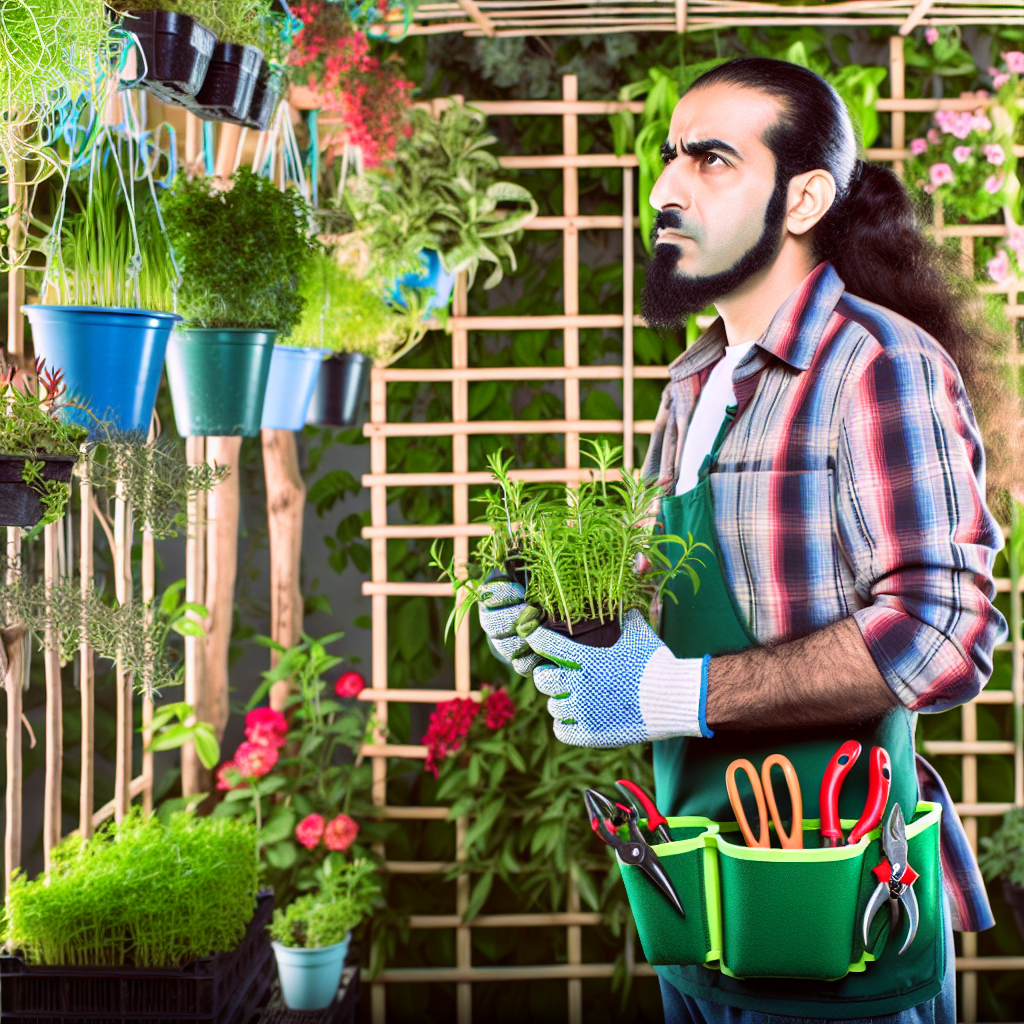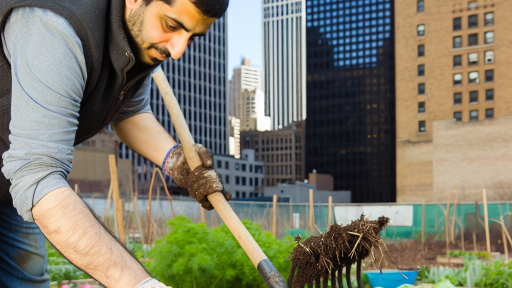Introduction to Vertical Gardening
What Vertical Gardening Is
Vertical gardening involves growing plants upwards instead of outwards.
This technique maximizes limited space in urban areas.
Gardeners can utilize walls, fences, and trellises for planting.
It creates a beautiful and lush environment in small areas.
Benefits of Vertical Gardening for Small Spaces
First, vertical gardening saves valuable ground space.
This method allows for the cultivation of more plants in less area.
Additionally, it improves air circulation around plants.
As a result, plants can grow healthier and resist diseases more effectively.
Environmental Impact
Vertical gardens contribute to urban greening initiatives.
They help reduce the urban heat island effect.
In turn, this promotes a healthier environment for residents.
Moreover, they assist in carbon dioxide absorption, improving air quality.
Enhanced Aesthetics
Vertical gardening adds visual appeal to any space.
These gardens can transform lifeless walls into vibrant green canvases.
They allow homeowners to express their creativity through diverse plant choices.
Transform Your Agribusiness
Unlock your farm's potential with expert advice tailored to your needs. Get actionable steps that drive real results.
Get StartedAdditionally, they create habitat opportunities for beneficial insects.
Practicality and Accessibility
Vertical gardening is practical for those with limited mobility.
It brings plants closer to eye level for easy access and care.
This technique encourages more individuals to engage in gardening.
Notably, it can promote mental well-being through nurturing plants.
Types of Vertical Gardening Systems
Wall-Mounted Planters
Wall-mounted planters conserve space by utilizing vertical wall areas.
These systems come in various styles and sizes to suit any space.
Additionally, they can enhance aesthetics while growing plants efficiently.
Pocket Planters
Pocket planters feature fabric or felt pockets to hold soil and plants.
They allow for easy planting and harvesting, making them user-friendly.
Moreover, they provide excellent drainage and aeration for the roots.
Vertical Hydroponic Systems
Hydroponic systems utilize nutrient-rich water instead of soil.
This method promotes faster growth and higher yields in smaller spaces.
Typically, they require a pump, reservoir, and tubing for effective operation.
Freestanding Vertical Gardens
Freestanding vertical gardens are portable and easy to set up anywhere.
These gardens often come with built-in irrigation systems for convenience.
They can be as simple as a tiered shelving unit filled with plants.
Living Walls
Living walls incorporate soil and plants into a structural design.
These systems can be complex but offer stunning visual effects.
They also improve insulation and air quality in surrounding spaces.
Vertical Trellis Systems
Trellis systems support climbing plants and create beautiful vertical displays.
They often pair well with flowering vines and vegetables.
These structures are typically made from wood, metal, or plastic materials.
Choosing a Suitable Vertical Gardening System
Choosing the right vertical gardening system depends on space and personal preferences.
Showcase Your Farming Business
Publish your professional farming services profile on our blog for a one-time fee of $200 and reach a dedicated audience of farmers and agribusiness owners.
Publish Your ProfileConsider combining various systems to maximize plant growth and enjoyment.
Ultimately, vertical gardening transforms compact areas into thriving green spaces.
Essential Tools and Materials for Vertical Gardening
Getting Started with Basic Tools
Vertical gardening requires specific tools for success.
Start with a quality pair of garden scissors.
Securing plants in place often needs durable twine.
A sturdy ladder can prove invaluable for reaching higher plants.
Invest in a watering can with a long spout for precision.
Choosing the Right Materials
Explore various planting containers suitable for vertical spaces.
Consider using recycled materials for eco-friendly options.
Wooden pallets can create attractive vertical garden structures.
Metal racks offer durability and sleek designs for modern gardens.
Plastic planters are lightweight and come in various colors.
Soil and Fertilizers
Utilize high-quality potting soil for vertical gardening.
Opt for soil that promotes drainage and aeration.
Organic fertilizers enhance plant growth healthily.
Consider liquid fertilizers for easy application.
Plant Selection
Choosing the right plants is crucial for vertical gardens.
Opt for herbs like basil, thyme, and chives.
Flowering plants such as sweet peas can add color.
Vegetables like lettuce and spinach thrive in vertical conditions.
Runner plants like strawberries cascade beautifully.
Support Structures and Accessories
Establish support structures for climbing plants effectively.
Trellises can provide essential support for vertical growth.
Wire mesh helps anchor heavier plants securely.
Plant hangers can also add variety to your design.
Maintenance Tools
Regular maintenance is essential for a successful vertical garden.
Keep pruning shears handy for trimming unnecessary growth.
A small trowel assists with repotting and soil management.
Gardening gloves protect your hands during maintenance tasks.
Finally, a spray bottle is perfect for misting delicate plants.
You Might Also Like: Sustainable Practices in Mushroom Agriculture
Choosing the Right Plants for Vertical Gardens: A Guide
Understanding Plant Needs
Selecting the appropriate plants for vertical gardens is crucial.
Different plants have varying light, water, and soil needs.
Understanding these requirements will help ensure a thriving garden.
Best Plants for Small Vertical Spaces
Opt for plants that flourish in confined spaces.
Consider herbs like basil, mint, and thyme.
They offer both culinary benefits and aesthetic appeal.
Additionally, compact flowering plants work well.
Examples include dwarf marigolds and petunias.
Attributes of Suitable Plants
Look for plants that grow upwards rather than outwards.
Showcase Your Farming Business
Publish your professional farming services profile on our blog for a one-time fee of $200 and reach a dedicated audience of farmers and agribusiness owners.
Publish Your ProfileVining plants such as ivy and pole beans are excellent choices.
These plants maximize space effectively.
Furthermore, choose plants with similar water and light demands.
This approach simplifies care and maintenance.
Utilizing Foliage and Color
Incorporate plants with varied foliage for visual interest.
Use contrasting colors to create seamless designs.
Consider adding trailing plants to enhance vertical layers.
Trailing plants, such as strawberries, can add depth.
Seasonal Considerations
Plan your vertical garden according to seasons.
Spring and summer allow for a wide variety of plants.
In contrast, select hardier plants for fall and winter.
Examples include certain evergreens and ornamental kales.
Space-Saving Techniques
Employ tiered planters for better organization.
Using wall-mounted pockets creates additional space.
Vertical racks can also maximize planting area.
Experiment with different setups to find what works best.
Vertical Garden Maintenance
Regular maintenance is essential for a healthy vertical garden.
Monitor water levels to prevent over or under-watering.
Prune plants as needed to encourage growth.
Lastly, watch for pests and treat them promptly.
Explore Further: Seasonal Care Tips for Heirloom Gardens
Design Ideas for Incorporating Vertical Gardens into Small Areas
Utilize Wall Space Efficiently
Vertical gardens make excellent use of wall space.
Install trellises to support climbing plants.
Consider wall-mounted planters for herbs or flowers.
Use pegboards or pallet wood to hang pots artistically.
Create a Vertical Garden with Shelving
Shelves provide multiple levels for various plants.
Arrange pots on sturdy shelves to save floor space.
Mix different plant sizes for visual interest.
Utilize lightweight, modular shelving for flexibility.
Incorporate Hanging Planters
Hanging planters add greenery without taking floor space.
Use ceiling hooks to suspend plants from above.
Macramé plant hangers create a decorative touch.
Mix and match planter colors for additional flair.
Transform a Balcony or Patio
Small outdoor areas can become lush gardens.
Use vertical rail planters on balcony railings.
Consider stacking planters to create height.
Incorporate a green wall for privacy and beauty.
Employ Modular Vertical Garden Systems
Modular vertical gardens are user-friendly and stylish.
Choose systems that allow for easy reconfiguration.
These systems are ideal for renters or small spaces.
Showcase Your Farming Business
Publish your professional farming services profile on our blog for a one-time fee of $200 and reach a dedicated audience of farmers and agribusiness owners.
Publish Your ProfilePlant on both sides for full-thickness greenery.
Leverage Vertical Garden Kits
Many companies offer vertical garden kits for convenience.
These kits often include everything needed for setup.
They work well for novices and seasoned gardeners alike.
Pay attention to product materials and plant choices.
Incorporate Irrigation Solutions
Efficient irrigation is vital for vertical gardens.
Consider drip irrigation systems for easy watering.
Automated timers can simplify the process further.
Ensure adequate drainage to prevent plant rot.
Delve into the Subject: Building A Seed Bank On Your Small Farm

Maintenance Tips for Healthy Vertical Gardens
Regular Watering
Ensure your vertical garden receives adequate water daily.
Check the moisture level in the soil regularly.
Use a drip irrigation system for consistent watering.
Adjust the watering schedule based on the weather.
Optimal Nutrition
Use high-quality fertilizer to promote healthy growth.
Apply fertilizers according to the requirements of specific plants.
Consider organic options for a more sustainable approach.
Feed your plants during the active growing season.
Pruning and Trimming
Regularly prune your plants to encourage fuller growth.
Trim back any dead or yellowing leaves promptly.
This practice helps prevent diseases from spreading.
Use clean, sharp tools for pruning to avoid injury.
Checking for Pests
Inspect your vertical garden frequently for signs of pests.
Common pests include aphids, spider mites, and whiteflies.
Apply natural pesticides as a first line of defense.
Encourage beneficial insects like ladybugs for pest control.
Providing Adequate Light
Position your vertical garden in an area with ample sunlight.
Adjust plant placement to ensure even light distribution.
Consider using artificial grow lights if necessary.
Monitor plants regularly to prevent leggy growth caused by insufficient light.
Seasonal Adjustments
Change the care routine with the shifting seasons.
In winter, reduce watering and protect sensitive plants.
During warmer months, ensure proper hydration and shade if needed.
Rotate plants to balance light exposure throughout the year.
See Related Content: Companion Planting Ideas for Organic Farms
Common Challenges in Vertical Gardening and How to Overcome Them
Limited Space
Many urban gardeners face limited space constraints.
Utilizing vertical gardening can maximize this space.
Consider wall-mounted planters to save floor space.
Additionally, use shelves to create layers of plants.
Poor Light Conditions
Insufficient sunlight can hinder plant growth.
Showcase Your Farming Business
Publish your professional farming services profile on our blog for a one-time fee of $200 and reach a dedicated audience of farmers and agribusiness owners.
Publish Your ProfileIdentify areas with the best natural light in your home.
Use grow lights to supplement daylight when needed.
Choose shade-tolerant plants for darker areas.
Watering Issues
Watering vertical gardens can be challenging.
Employ automated irrigation systems for consistency.
Use self-watering containers to minimize effort.
Regularly check moisture levels to prevent dry soil.
Nutrient Deficiencies
Vertical gardens can suffer from nutrient limitations.
Utilize high-quality potting mix enriched with fertilizers.
Regularly feed your plants with appropriate nutrients.
Consider using compost to boost soil health.
Pest Management
Pests can also target vertical gardens.
Inspect your plants regularly for any signs of infestation.
Use organic pest control methods to protect your garden.
Encourage beneficial insects to promote natural pest control.
Structural Integrity
Ensuring the stability of vertical setups is essential.
Choose sturdy materials for constructing vertical gardens.
Secure structures to prevent tipping or collapse.
Regularly check for wear and tear on components.
Sustainable Practices in Vertical Gardening: Eco-friendly Solutions
Choosing Sustainable Materials
Utilizing recycled materials is an excellent way to create vertical gardens.
Try using wooden pallets, old crates, or reclaimed wood for your structures.
These materials not only save money but also reduce waste.
Plus, they add a rustic charm to your garden.
Water Conservation Techniques
Implementing drip irrigation systems can greatly save water.
This method delivers water directly to the plant roots.
Another option is to collect rainwater for your garden.
Set up a simple barrel system to capture runoff from your roof.
Organic Plant Choices
Opt for native plants that thrive in your area.
Native plants require less water and support local wildlife.
Herbs, such as basil and cilantro, are great additions.
These plants enhance your meals while reducing environmental impact.
Composting Practices
Start a small compost bin to recycle kitchen scraps.
This process creates nutrient-rich soil for your plants.
Coffee grounds and vegetable peels can improve soil health.
Moreover, composting reduces landfill waste significantly.
Vertical Garden Designs
Incorporate vertical systems like pocket planters or wall-mounted shelves.
These designs maximize space while adding visual interest.
Consider using biodegradable pots to further minimize waste.
Utilizing hanging baskets can also create a stunning display.
Additional Resources
How to Start a Backyard Farm |
Showcase Your Farming Business
Publish your professional farming services profile on our blog for a one-time fee of $200 and reach a dedicated audience of farmers and agribusiness owners.
Publish Your ProfileIs Vertical Farming a Good Idea? No. It’s largely, though not entirely …




